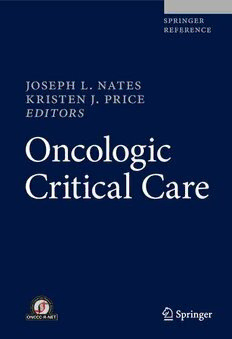
Oncologic Critical Care PDF
Preview Oncologic Critical Care
Joseph L. Nates Kristen J. Price Editors Oncologic Critical Care Oncologic Critical Care (cid:129) Joseph L. Nates Kristen J. Price Editors Oncologic Critical Care With225Figuresand278Tables Editors JosephL.Nates KristenJ.Price DepartmentofCriticalCareand DivisionofAnesthesiology RespiratoryCare CriticalCareand TheUniversityofTexasMDAnderson PainMedicine CancerCenter DepartmentofCriticalCareand Houston,TX,USA RespiratoryCare TheUniversityofTexasMDAnderson CancerCenter Houston,TX,USA ISBN978-3-319-74587-9 ISBN978-3-319-74588-6(eBook) ISBN 978-3-319-74589-3(printandelectronicbundle) https://doi.org/10.1007/978-3-319-74588-6 ©SpringerNatureSwitzerlandAG2020 Thisworkissubjecttocopyright.AllrightsarereservedbythePublisher,whetherthewholeor part of the material is concerned, specifically the rights of translation, reprinting, reuse of illustrations,recitation,broadcasting,reproductiononmicrofilmsorinanyotherphysicalway, andtransmissionorinformationstorageandretrieval,electronicadaptation,computersoftware,or bysimilarordissimilarmethodologynowknownorhereafterdeveloped. Theuseofgeneraldescriptivenames,registerednames,trademarks,servicemarks,etc.inthis publicationdoesnotimply,evenintheabsenceofaspecificstatement,thatsuchnamesareexempt fromtherelevantprotectivelawsandregulationsandthereforefreeforgeneraluse. Thepublisher,theauthors,andtheeditorsaresafetoassumethattheadviceandinformationinthis bookarebelievedtobetrueandaccurateatthedateofpublication.Neitherthepublishernorthe authorsortheeditorsgiveawarranty,expressorimplied,withrespecttothematerialcontained hereinorforanyerrorsoromissionsthatmayhavebeenmade.Thepublisherremainsneutralwith regardtojurisdictionalclaimsinpublishedmapsandinstitutionalaffiliations. ThisSpringerimprintispublishedbytheregisteredcompanySpringerNatureSwitzerlandAG. Theregisteredcompanyaddressis:Gewerbestrasse11,6330Cham,Switzerland We dedicate this book to our families for their patience and understanding during the long hours of work away from them We hope that this pioneering work leads to improvements in the care of the critically ill cancer patients around the world Preface TheGrowingNeed for Organized Oncologic Critical Care Services The world population continues its inexorable growth. Based on the United Nations’latestreportonworldpopulation,wehavereachedapopulationof7.5 billionpeopleofwhich1billionareover60yearsofage.Currently,thereare morethan549millionpeopleovertheageof60inAsia,practicallydoubling today’sUSpopulation.Thistrendhasbeennamedthe“silvertsunami”andits socialandhealthcareimpactworldwideisofgreatconcern.Asthepopulation rises,sodoesthenumberofnewcancercasesayear.Forthepasttwodecades, cancerhasbeenthesecondcauseofdeathforallagesinmostoftheworld.In 2012,theWorldCancerResearchFundandtheAmericanInstituteforCancer Researchestimatedthatthereweremorethan14millionnewcasesofcancer and 8.2 million related deaths. In 2018, the age-standardized rate for all cancers was 197.9 per 100,000 habitants. By 2030, the global burden of the disease is expected to reach 21.7 million new cases and 13 million deaths peryear. As the burden of cancer rises, the needs for supportive and critical care healthcareservicesexpand.Unfortunately,multiplefactorsareatworkagainst a timely and proportionate response from the critical care world. First, the supply and demand for critical care services is growing apart. The timely Committee on Manpower for Pulmonary and Critical Care Societies (COMPACCS) report of the distribution of critical care services in the USA clearlyshowedclearlythis threat.Second,as thecurrently trainedpersonnel age,theyretireandincreasethegrowingdeficit.Third,theneedforcriticalcare services increases as we get older, ranging from less than 1 specialist per 100,000habitantsat44yearsofageoryoungertomorethan9specialistsper 100,000habitants whenwereach 84yearsofageorolder.Fourth,thesharp increaseinhealthcarecostshasoverloadednationalbudgets.Thehighcostof numerousnewtechnologies,drugs,andtheinefficiencyofmostservicesarein parttoblame.Eventheorgan-basedapproach,whereamongothers,allheart, lung,andbrainproblemsaremanagedbythecardiologist,pulmonologist,and neurologist/neurosurgeon, respectively, contributes to the problem. Unfortu- nately,therearesomanyotherfactorsthatcontinuecompoundingtheabove challengesthatwecannotdiscussthemall.However,perhapsthegreatestof allisthatoncologiccriticalcaredoesnotexistassuch. vii viii Preface For decades, critically ill onco-hematologic patients have been denied admission to intensive care units around the world with the excuse of poor predictedoutcomes. Mostcritical careorganizationshavenotacknowledged this lack of access, do not have an oncologic section, and allocate minimal spaceforlecturesintheircongressesaboutthespecificproblemsonlyseenin thesepopulations.Specialtycollegesdonotrecognizethisasasubspecialtyor dedicateasignificantportionoftheirtrainingtoit. There is an urgentneed to develop a robust and organized response from ourspecialty.Thistextbook,thefirstofitsclass,andourinternationaleffortsin educationandresearcharepartofthisresponse.Asthefrontlineleadersand pioneersofthisnewfield,namelyOncologicCriticalCare,Iappealtoallof you to join us in the prevention and fight against cancer-related critical illnesses. FoundingPresidentofthe JosephL.Nates OncologicCriticalCareResearchNetwork October2019 Introduction Oncologic Critical Care: TheBirth of aNewSubspecialty ThefieldofCriticalCarehasgrownrapidlysinceitsbeginninginthe1950s. Withtheincreasingproportionofpersonsabove65yearsofagewitha50% overallriskofdevelopingcancerduringtheirlifetimes,cancerratescontinue to play a role in the utilization of healthcare services–particularly in the intensive care unit (ICU). This, coupled with a shortage of critical care pro- vidersinthenexttwodecades,makesidentifyingtheoutcomesoftheavailable oncologiccriticalcareresourcesimperative. Currently, no oncologic journals, subspecialty societies in the field, or adequate understanding about the current availability of oncologic/hemato- logicICUsexist.ExceptforourpublicationinSpanish,noothercomprehen- sivetextbooksinoncologiccriticalcareareavailable.Assuch,therearemajor knowledge gaps about outcomes (e.g., ICU utilization, mortality, costs), healthcare disparities (e.g., racial, geographic), and almost all aspects of intensivecaredeliverytothecriticallyillcancerpatient. This book, by serving as the first comprehensive source in Oncologic Critical Care, seeks to close these knowledge gaps and serve as a vehicle of education for the current and successive generations of healthcare providers dedicatedto the practice of Oncologic Critical Care. The book’s targetaudi- enceencompassesintensivists,medicaloncologists,surgicaloncologists,gen- eral physicians, hospitalists, advance practice providers, nurses, fellows, residents, medical students, and other healthcare providers that take care of cancerpatients.Thisworkisacollaborativeeffortamonginternationalexperts aimedatspecificallyfocusingonchallengesencounteredinthediagnosisand managementofthecriticallyillcancerpatientpopulation. This novel resource has 19 parts with over 140 chapters and more than 2,000 pages of care focused on the management of the critically ill cancer patient. It covers all aspects of what we consider a new subspecialty, Onco- logic Critical Care, thatarescarcelycovered instandard critical care books. Theincludedchaptersexplorethefollowingtopicsinoncologiccriticalcare: organization and management of an oncologic critical care unit, multi- disciplinary care and the integration of advance practice providers in this environment, all aspects of clinical pharmacy, and dermatologic complica- tions, and also neurologic, respiratory, cardiovascular, gastrointestinal, geni- tourinary, renal, and hematological diseases. In addition, we discuss ix x Introduction metabolic/endocrine and vascular complications, transfusion medicine prac- tices,infectiousdiseases,perioperativecareofthecriticallyillcancerpatient, care of special populations, critical care procedures and their challenges in coagulopathic patients, ethics, pain management, palliative care, and outcomes. Finally, we hope you enjoy and take full advantage of this amazing resource! JosephL.Nates KristenJ.Price Acknowledgments WewanttothankMr.KianK.AzimpoorandDr.AndrésF.Lasernafortheir outstanding and enthusiastic logistical support throughout the planning and executionofthisinvaluableproject. xi
